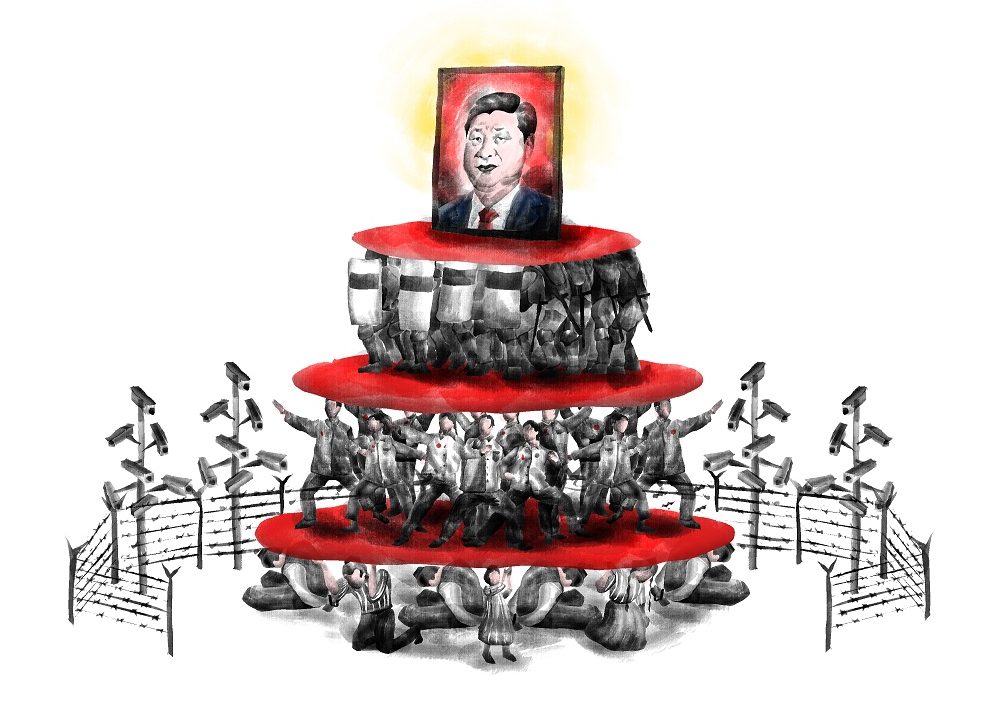
In China’s distant northwest city of Ürümqi, capital of the Xinjiang Uyghur Autonomous Region, the Political and Legal Affairs Commission sends ‘micro clues’ to neighbourhood committees and the police when someone does something irregular. That might be having an unexpected visitor at home, driving a car that belongs to someone else, receiving an overseas phone call, or using a file-sharing app.
The committee is a powerful organ of the Chinese Communist Party that oversees the ‘political and legal affairs system’, which includes the police, the procuratorate or Prosecutor General’s Office which controls the investigation and prosecution systems, the courts, the justice department and other security organs.
Elsewhere in China, the committee is typically a coordinating body without operational capabilities, but in Xinjiang it has prompted millions of investigations at the grassroots level. Between July 2016 and June 2017, it flagged 1,869,310 Uyghurs and other citizens in Xinjiang for using the Zapya file-sharing app.
China’s leader, Xi Jinping, has dubbed the political and legal affairs system the party’s ‘knife handle’ and insists that it must be firmly in the hands of the CCP and the masses.
How this vast system of coercive state control works is examined in a new project from ASPI’s International Cyber Policy Centre, The architecture of repression: unpacking Xinjiang’s governance.
Analysing thousands of pages of leaked police files, ASPI researchers have gained rare insights into the methods used by the CCP to oppress Uyghurs and other indigenous communities in Xinjiang.
The project includes an interactive organisational chart, profiling over 170 offices that have participated in Xinjiang’s governance in the past seven years. Within the chart, guided tours can take the viewer through five key sets of Xinjiang’s repressive policies: mass internment, forced labour, mass at-home surveillance, coercive birth control and ubiquitous propaganda.
An 82-page research report draws on previously unpublished material from thousands of Chinese-language sources, including police records and budget documents obtained by scraping Chinese government websites.
Since mass Uyghur internment was first reported in 2017, a rich body of literature has documented the ongoing human rights abuses in Xinjiang. However, there is little knowledge of the government processes or actual perpetrators of these now well-known atrocities, and only a small number of entities or individuals have been identified for their involvement.
This project exposes these activities, and those responsible, to further public scrutiny.
Amid international debates about whether recent events in Xinjiang constitute genocide, and while Chinese officials are actively scrubbing relevant evidence and seeking to silence those who speak out, it is important to carry out a timely and detailed investigation into Xinjiang’s governance now.
The report highlights, as an example, the treatment of Anayit Abliz, then 18, who was caught using a file-sharing app in 2017. He was interned in a re-education camp and eventually ‘sentenced’ by his neighbourhood committee, a nominally service-oriented voluntary organisation responsible for local party control, to three years in prison.
While he was detained, officials from the committee visited his family members six times in a single week, scrutinising their behaviour and observing whether they were emotionally stable.
Our report is the first English-language report to analyse Xinjiang’s ‘Trinity’ mechanism, which grants the neighbourhood committees extraordinary powers to police the movements and emotions of residents, subjecting many to ‘management and control’ orders akin to house arrest.
The crackdown against the Uyghurs has a striking resemblance to Mao-era mass political campaigns.
Even though Xi had declared such campaigns to be costly and burdensome, the party-state is using them in Xinjiang, and elsewhere. In addition to mass internment and coercive labour assignments, Xinjiang residents are compelled to participate in acts of political theatre, such as show trials, public denunciation sessions, loyalty pledges, sermon-like ‘propaganda lectures’ and chants for Xi’s good health.
They are mobilised to attack shadowy enemies hiding among them, the so-called ‘three evil forces’ and ‘two-faced people’.
The report highlights the whole-of government and whole-of society approach to Xinjiang’s crackdown, naming an astounding number of offices and officials involved in its repressive policies. They include obscure agencies such as the Forestry Bureau, which looked after Kashgar City’s re-education camps’ accounts for a year.
Three Xinjiang county party secretaries are profiled, including Yao Ning, who was a visiting fellow at Harvard University and now sits atop a chain of command overseeing nine newly built or expanded detention facilities in southern Xinjiang. Erken Tuniyaz, who was appointed Xinjiang’s new acting governor on 30 September, also spent time at Harvard as a visiting fellow.
Highly destructive mass political campaigns are not artefacts of a bygone era. Rather, they are occurring at a time when Chinese society is more closely connected with the world than ever. Consequently, through long and complicated supply chains, liberal democracies have found themselves consuming (often unknowingly) the outputs of China’s mass political campaigns, such as products made with forced labour. Pursued along racial and religious lines, Xinjiang’s campaign against the Uyghurs has also led to accusations of genocide.
Since the spring of 2017, it has been widely accepted that between several hundred thousand and a million Uyghurs and other indigenous people in Xinjiang have been rounded up and interned in what Chinese authorities call ‘vocational education and training centres’. Yet these re-education camps are only the most visible components of a vast architecture of repression in the region.

